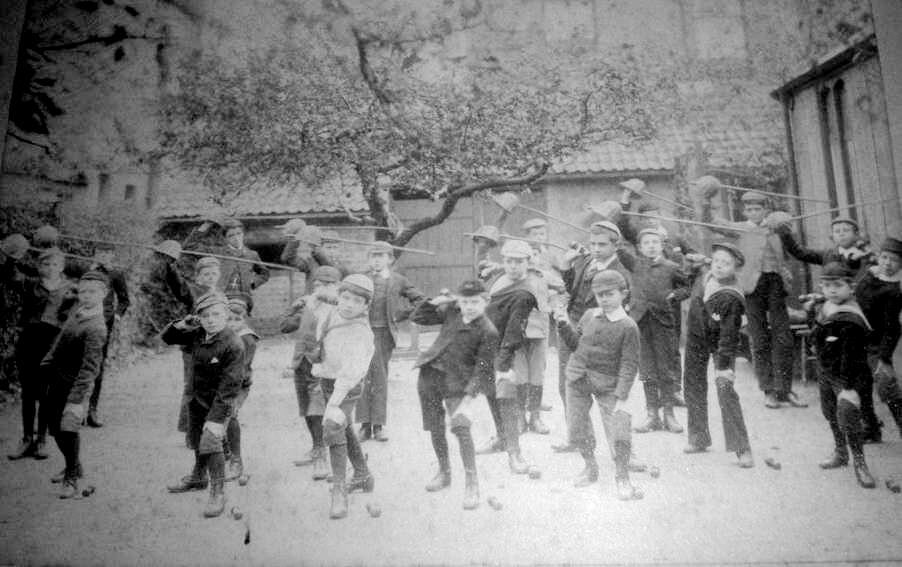
English School Activities: Drill --20th Century

Figure 1.--This cbinet-card portrait shows a class doing drill holding fencing foils. This suggests to us a private preparatot school because a state primary would not have foils. The boys probanly liked the idea to make drill a little nore interesting. The photograph is undated, but we wold guess was taken just after the turn-of-the century in the early-1900s. Both the clothing and the mount style suggest the early-1900s. The studio was Robt. J. Dubbin in Kingston Upon Thames.
|
|
Drill continued to be widely used in schools in the early-20th century. We see numerous examples in the photographic record. Drill declined, however, as the cntury rogressed, especially after World War I in the 1920s. There were differnt reasons for this. World War I increased interest in school physical education programs. [Camp] Many young men were found not to be healthy enough for military service. It was first brought to national attention during the Bohr War. Even before the War, this was a prime mover for Baden Powell's interest in the youth movement. The shift fro drill to other activities can be seen in the national curriculum. It was very muh present in the 1903 model curriclum. After the Workd war I se bgin o seen increasingly modern approahes to pgysical education. [Lowe] This was presumably bcause of the rising importance of sports in English life. Physical educations begn to diversifyand increasingly usd sport that the children found more interesting. While drill began to ecline it did not immediately disppear. We see children during drill through the 1930s. We note children at the Douglas School, probably in the 1920s. We no longer see drill to ny extent after World War II.
Sources
Camp, Frederick S. "Physical education and military drill: What should be our policy," Th School Review: A Journal of Secodary Education Vol. XXV, No. 8 ()ctober 1917&, pp. 537-45.
Lowe, Ed. "Drill, physical training and physical education in state schools," Prezi (March 23, 2017).
HBC-SU

Related Chronolgy Pages in the Boys' Historical Web Site
[Main Chronology Page]
[The 1880s]
[The 1930s]
[The 1940s]
[The 1950s]
[The 1960s]
[The 1970s]
[The 1980s]
Related Style Pages in the Boys' Historical Web Site
[Main country page]
[Long pants suits]
[Short pants suits]
[Socks]
[Eton suits]
[Jacket and trousers]
[Blazer
[School sandals]
Navigate the HBC Country School Pages
[Main School Page]
[Australia]
[England]
[France]
[Germany]
[Italy]
[Japan]
[New Zealand]
[Scotland]
[United States]
Navigate the HBC School Section:
[Return to the Main English school uniform gym/games]
[Return to the Main English school uniform gym/games page]
[About Us]
[Activities]
[Chronology]
[Clothing styles]
[Countries]
[Debate]
[Economics]
[Garment]
[Gender]
[Hair]
[History]
[Home trends]
[Literary characters]
[School types]
[Significance]
[Transport and travel
[Uniform regulations]
[Year level]
[Other topics]
[Images]
[Links]
[Registration]
[Tools]
[Return to the Historic Boys' School Home]
Created: 9:51 PM 4/6/2018
Last updated: 9:52 PM 4/6/2018




